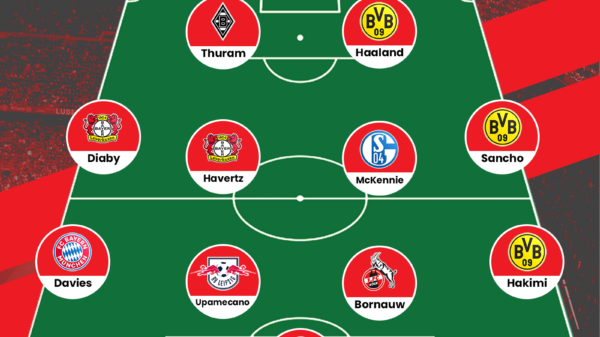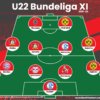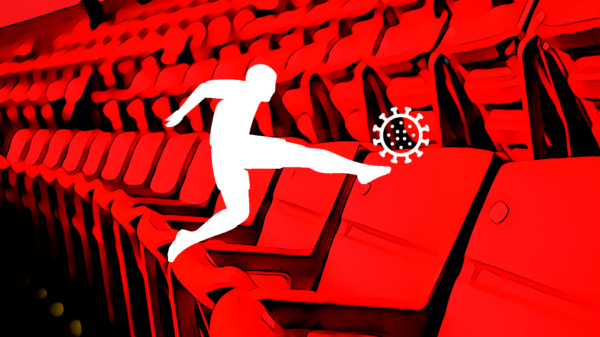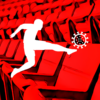A better second half to the season saw Borussia Dortmund claw into the European places but there’s no doubt that the German giants struggled to match the success of earlier years in Jurgen Klopp’s last season in charge. While injuries played a big role in their troubles, it was far from the only reason says Constantin Eckner.
It was not the happy ending everyone at the club wanted. Borussia Dortmund lost to VfL Wolfsburg in the DFB Pokal final in what was Jürgen Klopp’s last match as BVB coach. After being at rock bottom in February, the Schwarzgelben were able to gain momentum and eventually reached seventh place in Bundesliga. That means they will play the Europa League qualifiers, when Thomas Tuchel takes over as new manager at Signal Iduna Park. But after a disappointing season, the reasons behind what went wrong must be investigated. Here are ten points, raising no claim to completeness.
Replacing Lewandowski
Losing a world-class striker is never a good thing. Robert Lewandowski came to Dortmund in 2010 and since the beginning of his second season, was BVB’s target man up front, receiving many long balls even when they were played rather inaccurately. Dortmund’s system of attacking transition play was dependent on Lewandowski’s ability of receiving the ball and passing it on. The Pole often stood alone up front, and it was therefore necessary to defer the attacks when he had the ball at his feet, giving the likes of Marco Reus and Henrikh Mkhitaryan time to move up the field.
Last summer, Borussia signed Adrián Ramos and Ciro Immobile with the duo expected to replace Lewandowski. But eventually Pierre-Emerick Aubameyang became their most dangerous striker. The Gabonese International possesses tremendous speed, but he sometimes struggles to find the right zones and to hold his own in tight pockets of spaces.
With the loss of Lewandowski the whole system had to change, but Klopp unfortunately did not seize the moment to make adjustments, especially when Dortmund were struggling to create effective pass combinations in the second and last third.
For example, Immobile has clear technical weaknesses. Therefore, he is more of a passive player, generally staying away from deeper pass circulations and focusing only on actions within the penalty box. With Immobile being fielded, only nine outfield players are usually involved in pass circulations.
But those who think this was just a one-time mistake in the transfer market could be wrong. We should look at Dortmund’s transfer activities over the past years. After losing the likes of Shinji Kagawa and Mario Götze, the Schwarzgelben tended to sign or promote more athletic players with less technical abilities: Pierre-Emerick Aubameyang, Kevin Kampl, Ciro Immobile, Adrián Ramos, Miloš Jojić or Erik Durm. They all love to play with speed in open spaces, while struggling to play combinations and in narrow situations.
Injuries a constant companion
Dortmund could not play with their best starting eleven on any matchday of the campaign. Throughout the last years, injuries played a major role. Since fitness specialist Oliver Bartlett, who has shown off his ability under Roger Schmidt in recent years, had left the Signal Iduna Park in 2012, Dortmund has struggled with a huge amount of injuries, especially minor muscle injuries that put players on the sidelines for two or three matches.
According to Transfermarkt and Fussballverletzungen, first team players picked up 116 injuries this season, missing 1626 match or training days in all. 38 injuries related to muscles – mostly thigh and adductors – resulted in Dortmund players missing 546 days altogether. It is noteworthy, that Bayer Leverkusen, where Bartlett is in charge, had only 799 absent days, with 244 as a result of muscle problems, despite playing a very intense system.
The outspoken fitness pundit and professional football coach Raymond Verheijen explained once the correlation between the time of regeneration and injuries. “Accumulation of fatigue due to insufficient recovery makes the nervous system slower. The signal from brain to muscles travel slower”, wrote Verheijen, who has worked with the national teams of Wales and the Netherlands. “If the signal from the brain arrives later in the muscles this means the brain has less control over body during explosive football actions. So there’s much evidence that insufficient recovery, accumulation of fatigue and slower nervous system are dramatically increasing injury risks.”
Struggling key players
Germany’s World Cup victory was a great achievement. However, some players involved struggled to regain their form afterwards. An obvious example is Mats Hummels. Having been promoted to team captain, the 26-year-old centre-back looked sloppy in terms of timing and tackling during the season. He chose wrong situations to leave the back four, trying to press the opposing team in midfield and in general looked stiff in duels against agile Bundesliga strikers. All in all, he could not play to his potential.
He was not alone, though. Marco Reus kept getting injured, Shinji Kagawa has struggled to regain the Dortmund form of old, and Henrikh Mkhitaryan wrestled with many turnovers and wrong decisions in the final third in the Hinrunde. Moreover, Roman Weidenfeller, their old warhorse between the sticks, has been in a decline for quite a while. He cannot be involved in build-up play that much, as well as being unsuccessful when leaving the goal-line on many occasions.

Hummels struggled to sustain his form after the World Cup. Via Squawka’s Comparison Matrixs
Aspiring to be a dominant force
After years of being one of Europe’s leading teams in terms of pressing and Gegenpressing, Dortmund aspired to develop their system. Klopp aimed to change some facets of the system for the second time. Already after his first Bundesliga title in 2011, the Dortmund coach had the idea of implementing a more possession-oriented system. At that time, the Schwarzgelben signed İlkay Gündoğan, with Mario Götze and Shinji Kagawa also playing in the centre. However, the ball circulation did not evolve to a level where Dortmund could outplay their domestic opponents. Quite to the contrary, Klopp’s side had severe problems in filling the right zones at the right time. There were too many holes while circulating the ball within their own lines, and they were not arranged in an appropriate staggered manner. Klopp returned to the old approach of interception and transition attacks back in late 2011.
When the 47 year-old tried formations such as a 4-3-1-2 (midfield diamond) last summer, Dortmund were made to pay against decent pressing approaches by many Bundesliga teams. Many coaches responded to BVB’s anticipated dominance very well, leading their early build-up to the wings and then subsequently isolating them. Klopp returned to the old approach once again.
Sticking to the same formation
A major reason for that was the consistency of their customary 4-2-3-1 shape. In this formation the spaces are occupied very evenly which makes it quite a standard setup – perhaps too much so. A 4-2-3-1 formation does not contain any asymmetries or holes on the field. A coach can use different types of players at a particular position, but particularly in a match of two 4-2-3-1 teams, which is a common occurrence in the Bundesliga, both sides tend to neutralize each other. Less overload situations and synergies between various positions make it difficult to transform the shape situationally.
Eventually, this monotony with respect to the formation can lead to unimaginative attacking plays and the consistent repetition of simple procedures offensively and defensively. Psychologically speaking, such factors cause thoughtlessness and eventually dissatisfaction, when very familiar moves do not lead to successful events on the field. The players needs new stimuli after a certain period – small changes after every tenth game or so like Lucien Favre implements at Borussia M’Gladbach or tactical paradigm changes after a couple of seasons. Klopp did none of this during the last part of his tenure.
Lacking build-up structures
Another major issue was that Dortmund struggled to build up their attacks effectively. Particularly during the last season their presence in the middle was not ensured, as Gündoğan had to drop between both centre-backs while the other centre midfielder and the no. 10 stood in a vertical line. The lack of triangles and a strong focus on width constantly remained. A narrow opposing block could lead Dortmund to the wings, because Gündoğan and both centre-backs did not have any other option. The full-backs usually received the ball with their back to the opposing goal and a defending player right behind them.
If you are going to play immediately to the wing, the full-back should at least move into the centre, opening the zone for an attacking winger, while the higher positioned central midfielder or the no. 10 could also run in direction to the ball.
The most promising constellation appeared to be when Gündoğan played alongside Nuri Şahin in central midfield, which happened just a few times because of the many injuries they had to deal with. Şahin stayed in the centre, protecting Gündoğan, while he moved around him, distributing the ball to Dortmund’s attacking players. Both Şahin and Gündoğan are capable of playing accurate passes even under the pressure of the opposing high press.
Lower pressing intensity
The pressing system we saw in Dortmund’s golden era two or three years ago was universally usable and had therefore less in common with the pressing system of last season. When Dortmund were on a roll, playing for the German title or genuine contenders for the Champions League, they were able to adjust to any opposing build-up structure. Last summer, Klopp attempted to tune the system by utilizing new option-oriented elements. Because of an extremely high intensity, Klopp’s athletic players were perfectly suited to the required roles, covering all necessary spaces in every situation in adddition to creating well-organized pressing traps.
However, after the first loss against Leverkusen in the first match of the campaign and following injuries that side-lined some important players, Dortmund’s perfection in terms of pressing was gone. The problems regarding possession football were even more exposed, though. Then, their pressing traps could not surprise any opponent, as Klopp’s players tended to make the same runs and moves over and over again. The pressing system looked mechanical and was not capable of adapting.
Creating Gegenpressing situations
Nevertheless, Dortmund could and still can rely on a pretty decent basis of group-tactics and collective processes in defence. Klopp’s side were able to win balls back very quickly via Gegenpressing – even in the worst moments of the season.
“Gegenpressing is the best playmaker,” one of Klopp’s most famous quotes, became some sort of a credo at Dortmund. However, the tactically intelligent Bundesliga have found ways to overcome BVB’s pressure immediately after turnovers.
That has to do with the fact that many German teams – unlike M’Gladbach for instance – use some kind of midfield pressing in the first place. Thus, it is hard to intercept the ball more up front than around the half-way line. As a consequence of struggling with their own build-up play, Dortmund often cannot even carry the ball in higher zones, where their Gegenpressing is more effective, when losing the ball. Winning the ball at the half-way line means Klopp’s players have a long way to go to the opposing goal.

Dortmund can win the ball back via Gegenpressing, but the opposing team has enough players behind the ball
Bundesliga’s resistance against the counter
The Bundesliga is one hell of an entertaining league, drawing attention from all other the world. Sold out stadiums, fan-owned clubs and thriving teams have ensured its rise in recent years. However, many teams are still (or again) focusing on playing long balls, using pressing and chasing counter attacking opportunities.
Regarding Borussia Dortmund, that is the most disadvantageous set-up they could possibly face. Klopp’s side had to deal with deep sitting collectives and low-risk approaches during the last campaigns. Many opponents refrained from playing the ball out of the back four through the middle and kept many players behind the ball, while focusing on outer zones. Combined with the lack of surprise in terms of pressing, Dortmund could not catch the ball where they were able to switch over to attacking plays effectively – which are usually the central zones.
And again, Dortmund’s problems with their own build-up structure and possession football came into effect. If you cannot hit your opponent on the break, you need very bold pressing traps to lure them into uncomfortable situations where they depart from their initial tactics or you have to outplay the opposing team while carrying the ball down the field.
Shot conversion
Analysing some numbers, you could possibly think Dortmund played a decent season. Models like Expected Goals saw Dortmund in the third or fourth place of the Bundesliga, and, of course, not at rock bottom where they were in winter.
When it comes to shots ratio, BVB were only behind Bayern Munich and level with Bayer Leverkusen. Jürgen Klopp’s team faced, as just one of three teams, only a single-digit number of opposing shots per game, but still had the second most shots on the other side. Taking only the values from Total Shots Ratio (TSR) / Shots on Target Ratio (SOTR) into account, Dortmund continued to be a top team.
However, the PDO numbers look even worse. As regards to Save Percentage, BVB were in the penultimate rank. In terms of Shot Conversion Rate, Dortmund ranked fifteenth.
This certainly begs the question whether it were just a one-time slip-up with a bad conversion of chances on one hand and bad shot stopping on the other hand or was it a result of more systemic and long-term deficiencies behind it. However, it is tough to analyse long-term developments, as Jürgen Klopp’s time is up and key players like İlkay Gündoğan and Sebastian Kehl will leave the club or retire.
Under newly signed coach Thomas Tuchel the face of Borussia Dortmund will most likely change. “Dortmund is famous for attacking football,” Tuchel said at a recent press conference. “We want to be proactive and play dominantly. We will need every aspect of the game.” Tuchel is aiming to achieve something that Klopp simply could not in his last season at Dortmund.
Written by Constantin Eckner
- Tactical Philosophy: Thomas Tuchel - July 24, 2015
- Borussia Dortmund: What went wrong? - June 11, 2015
- Why Kevin Kampl has been so important for Dortmund’s revival - March 4, 2015

































































